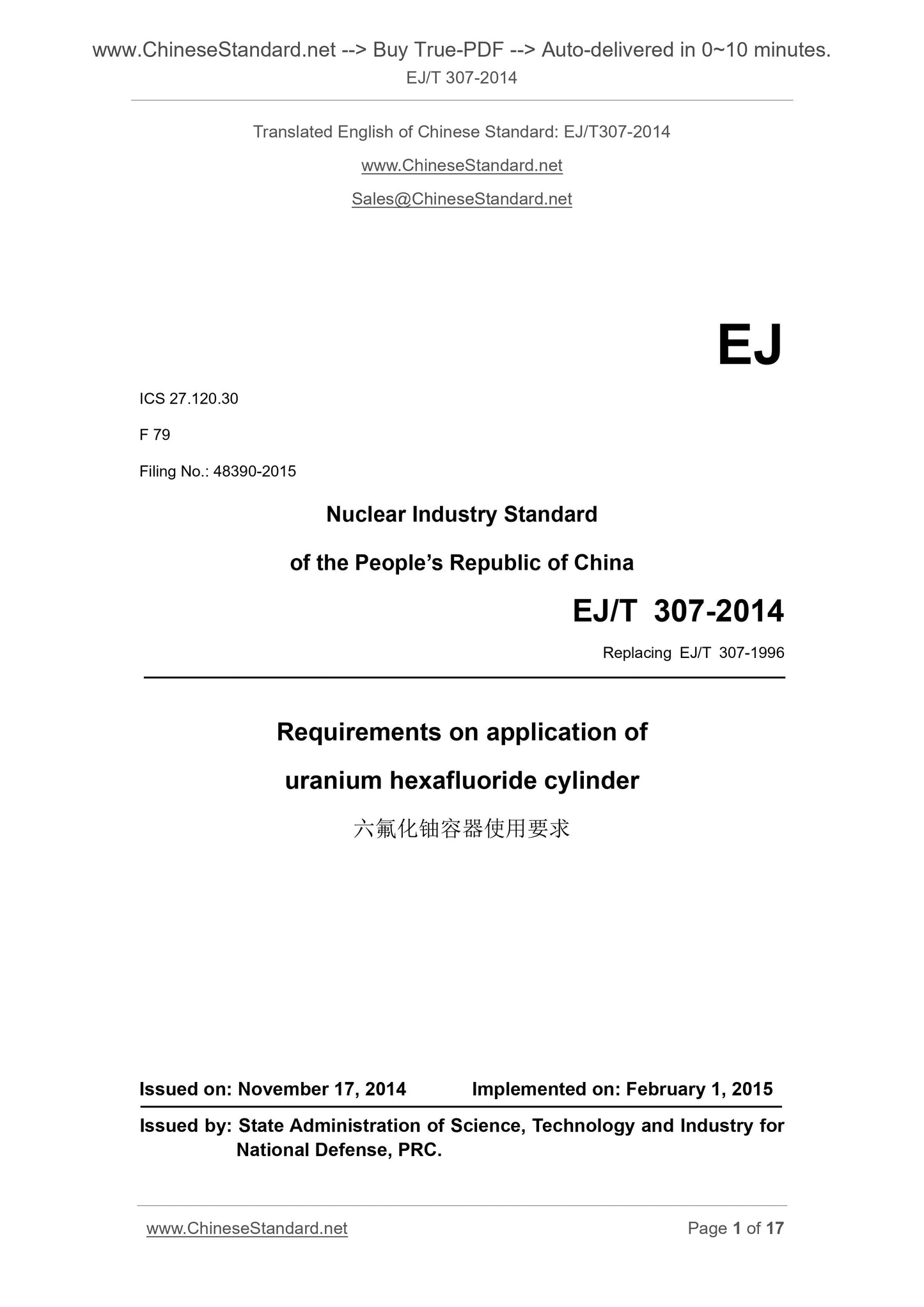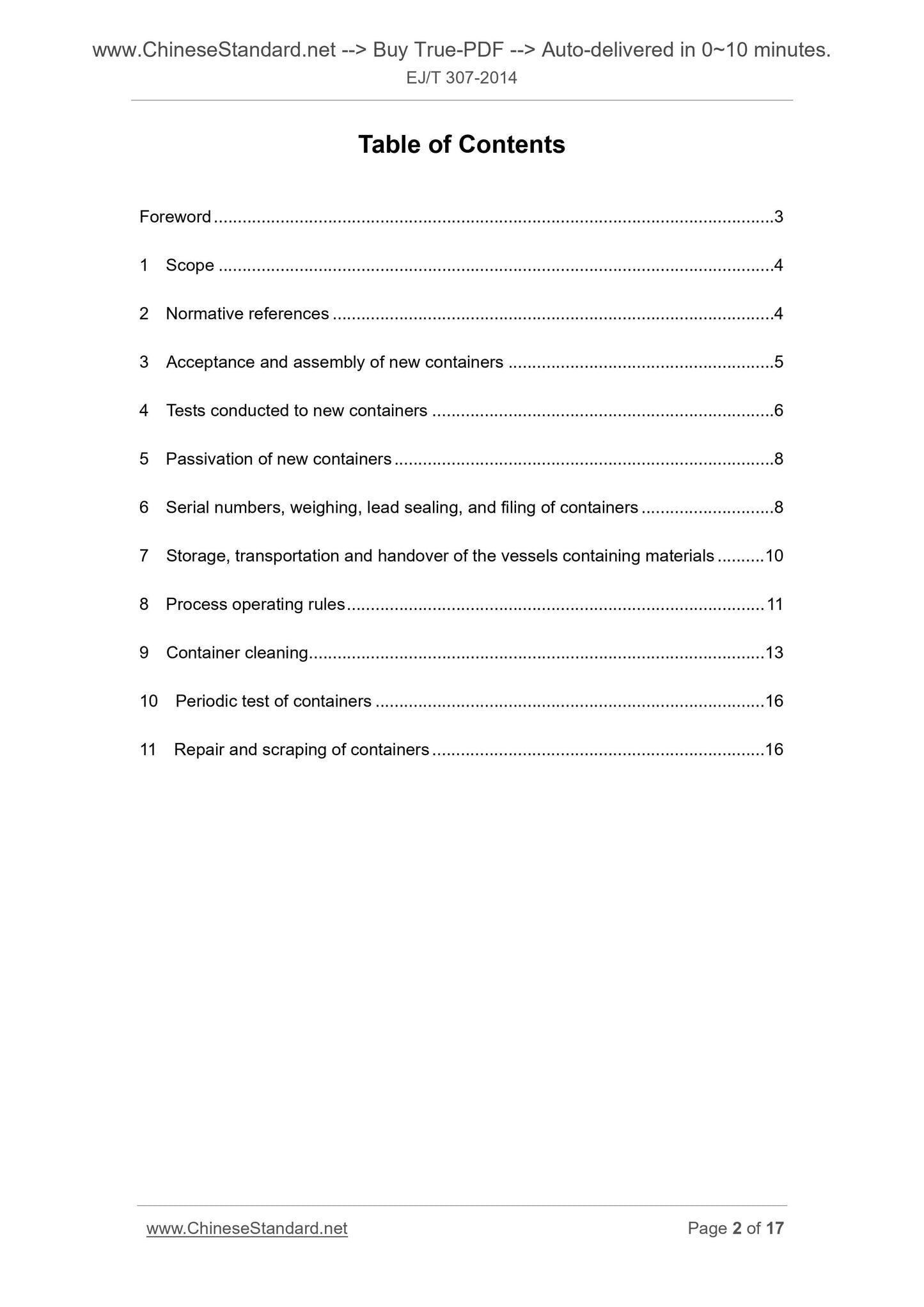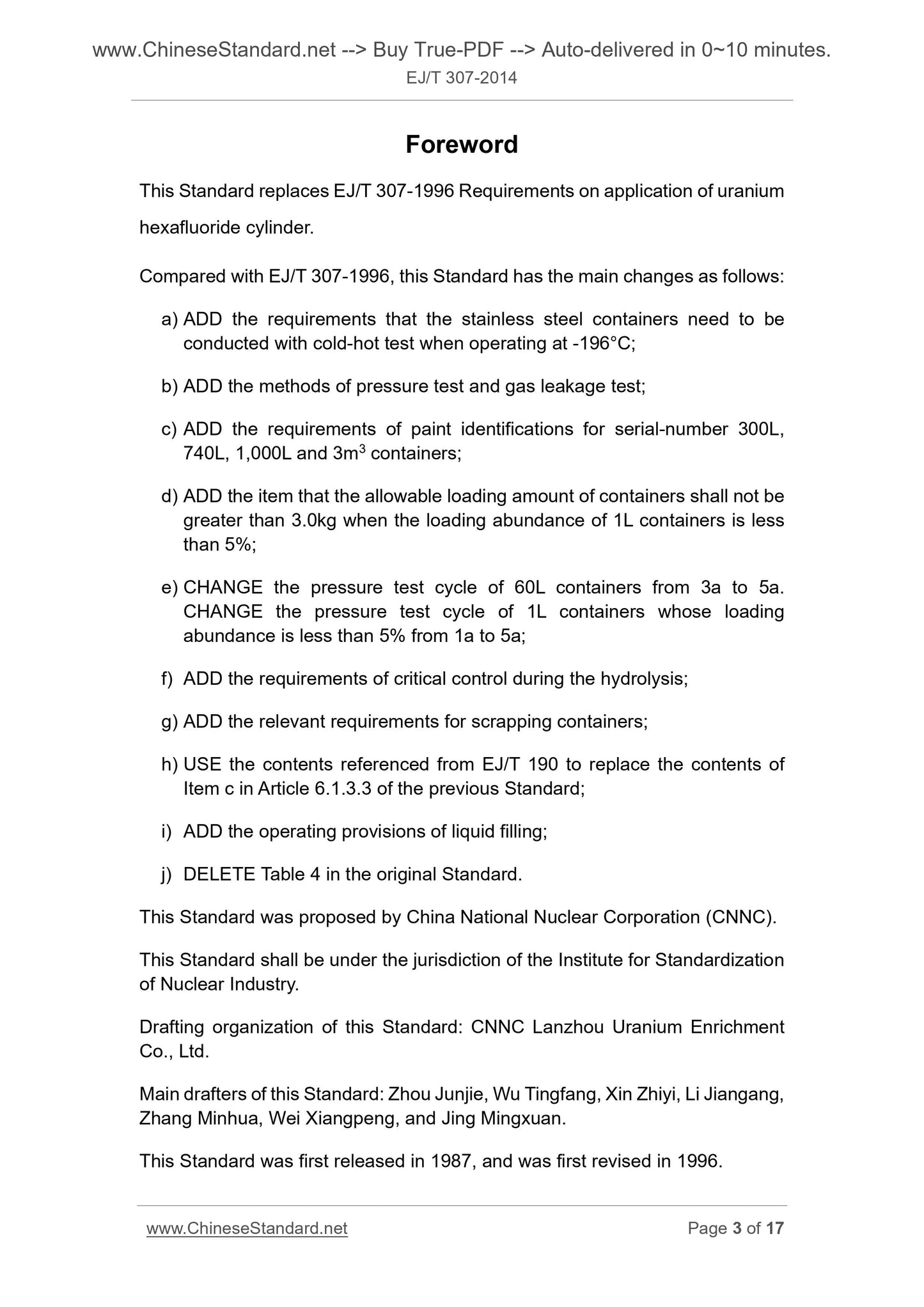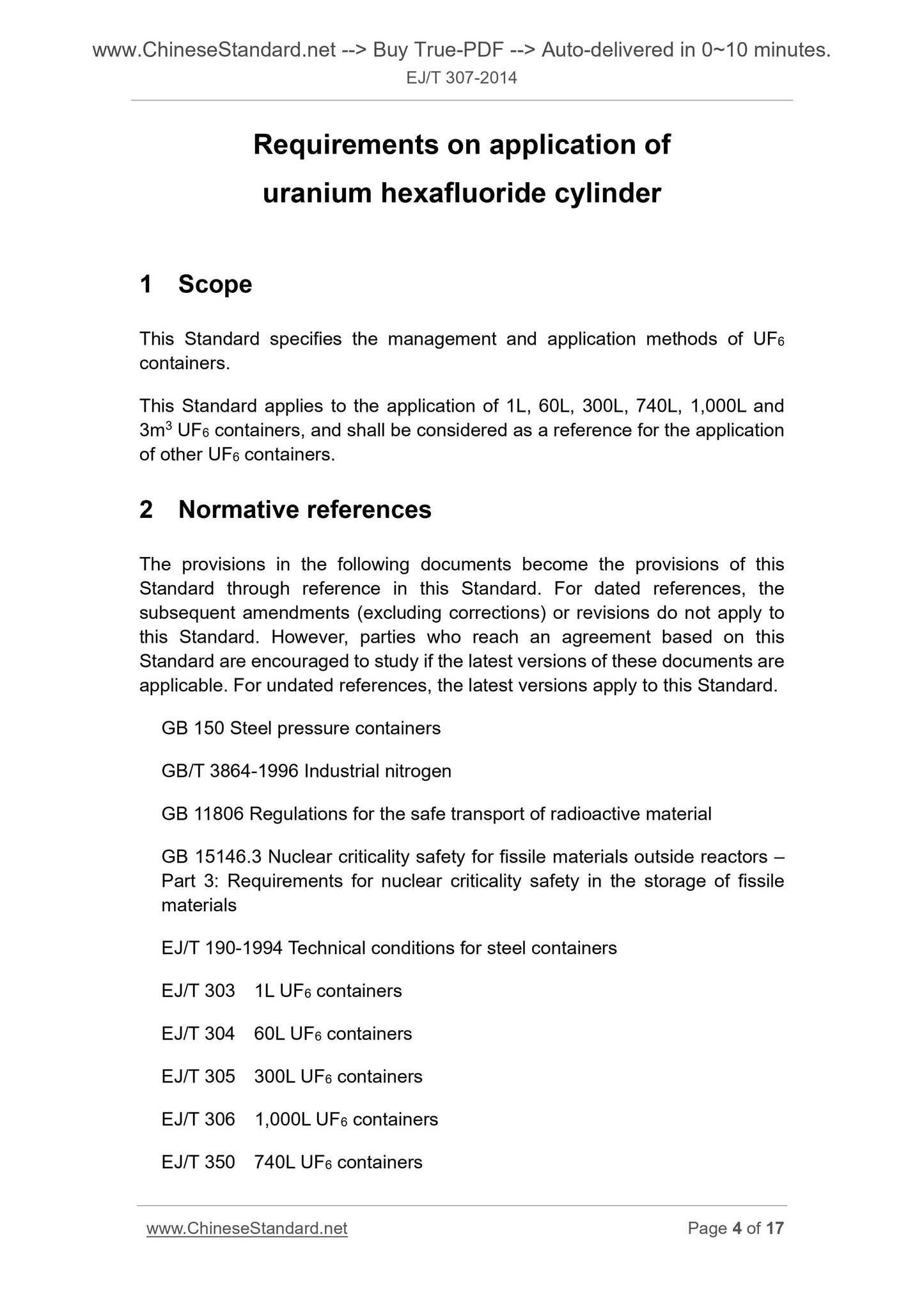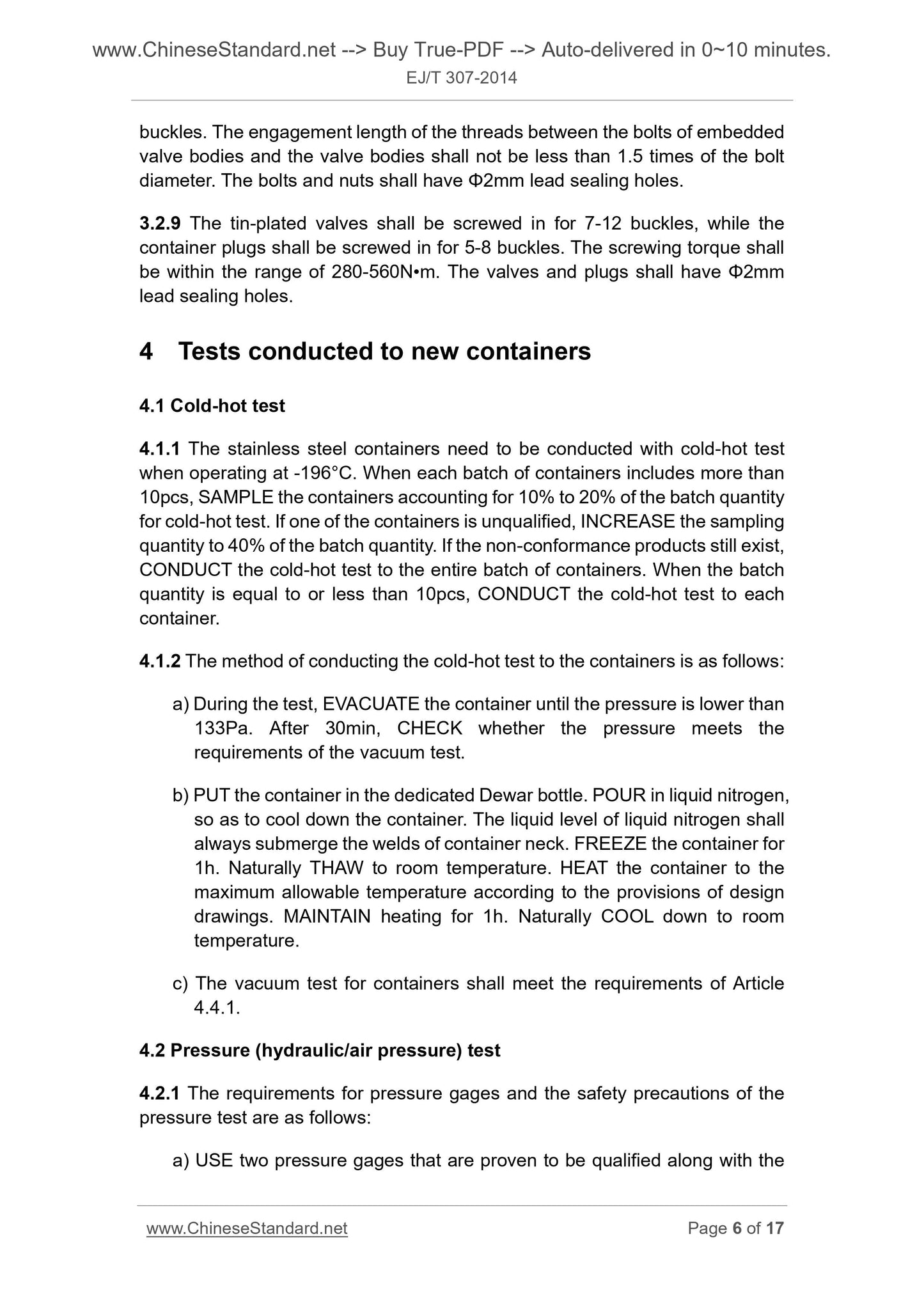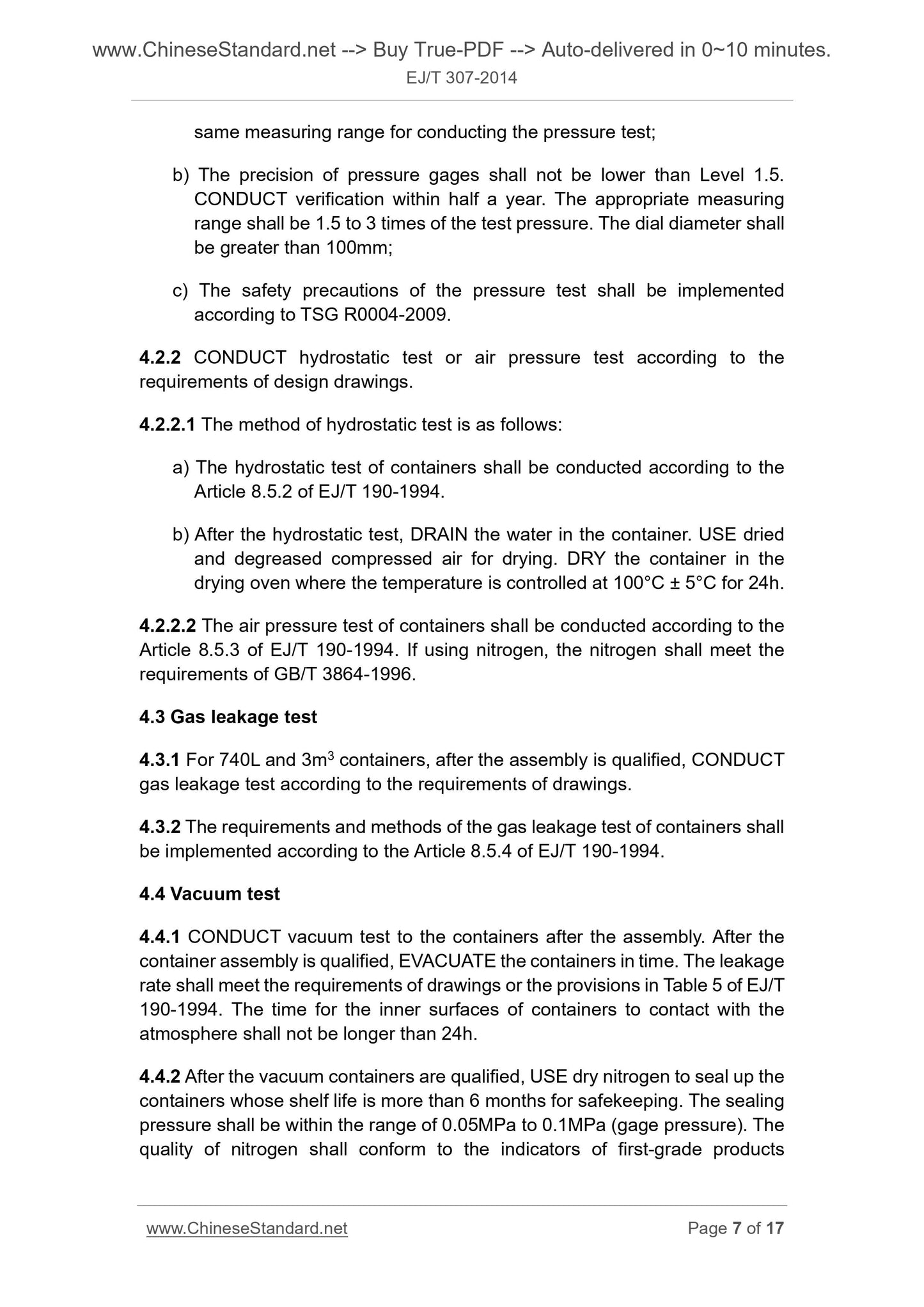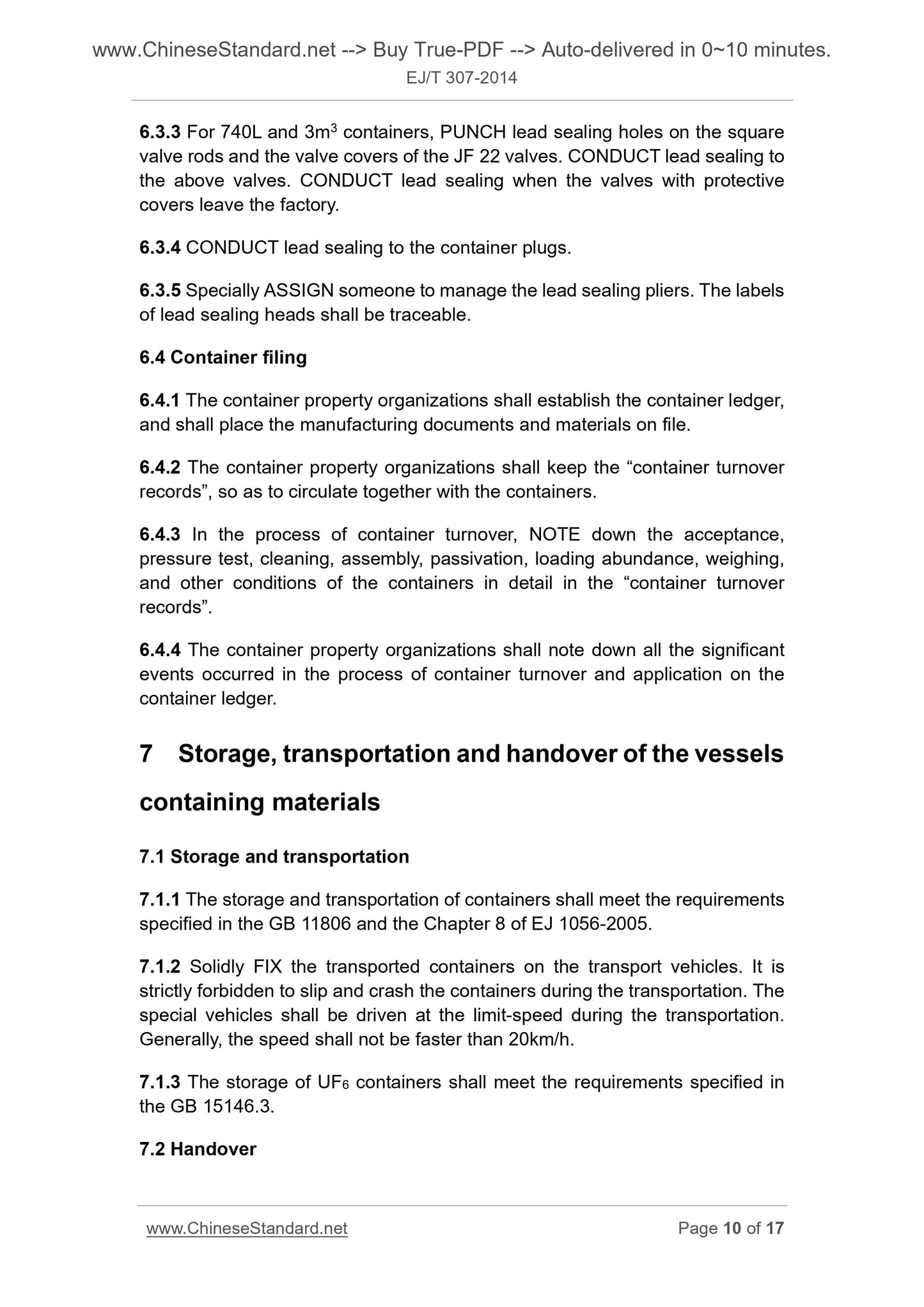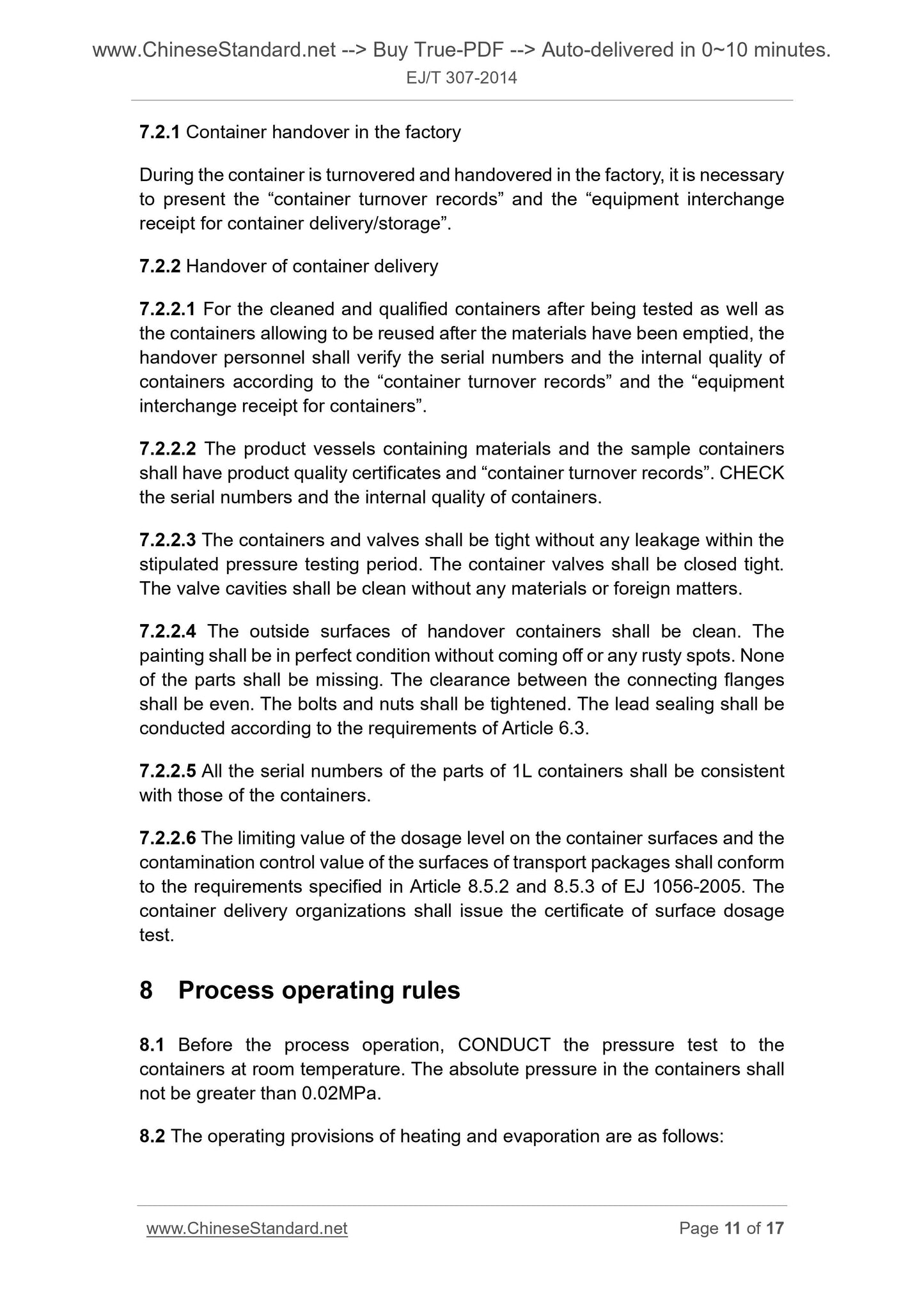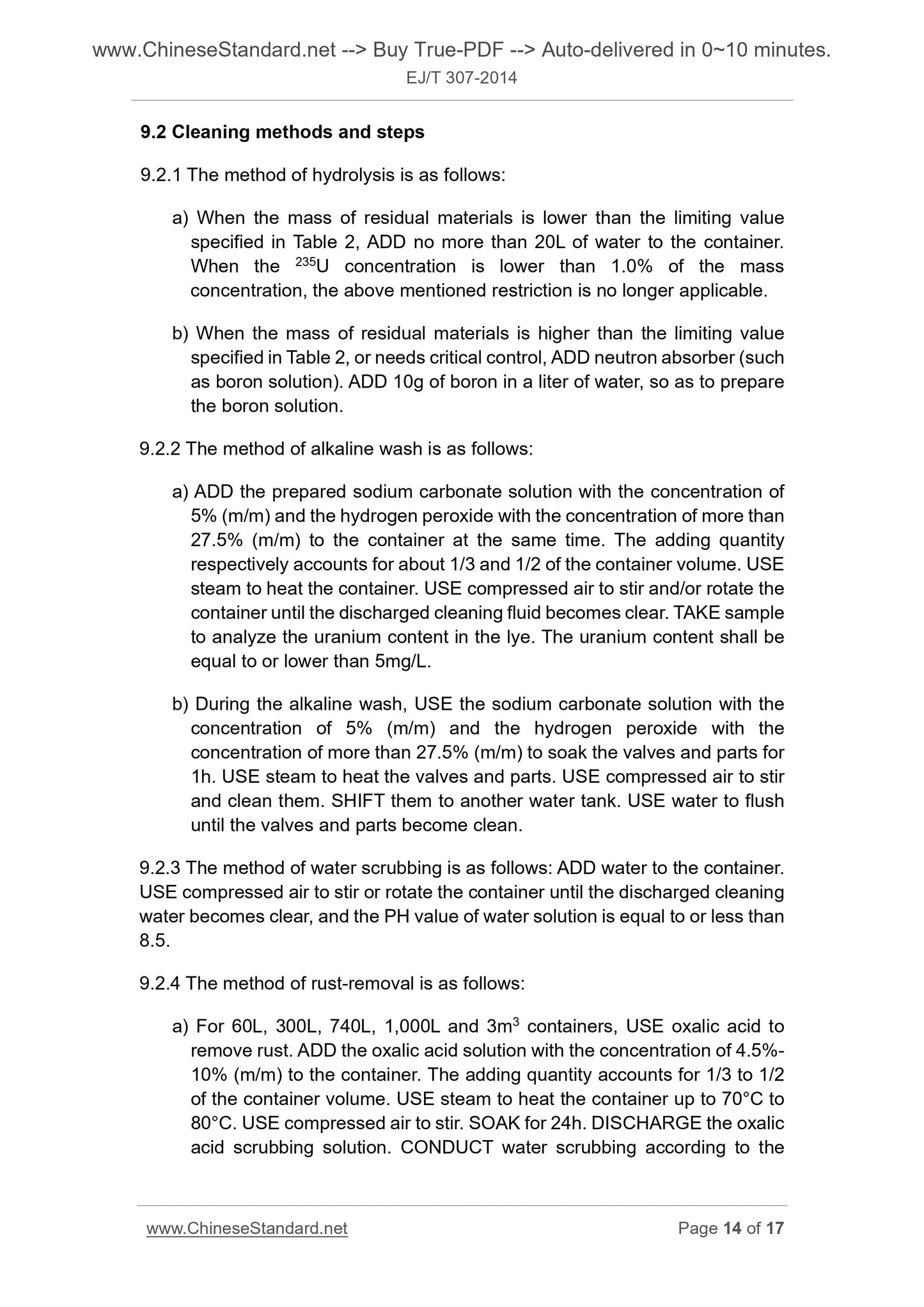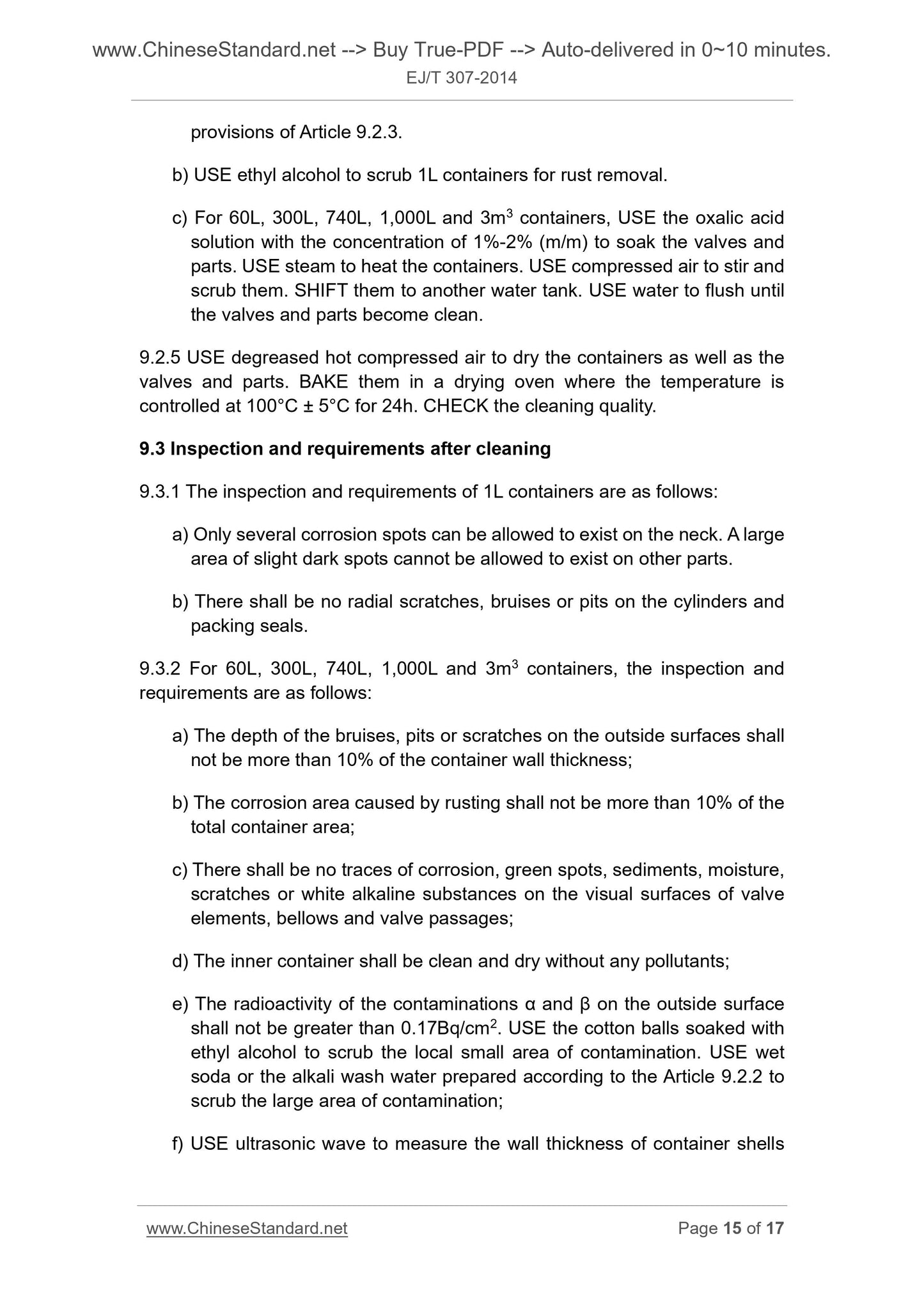1
/
의
10
PayPal, credit cards. Download editable-PDF and invoice in 1 second!
EJ/T 307-2014 English PDF (EJT307-2014)
EJ/T 307-2014 English PDF (EJT307-2014)
정가
$150.00 USD
정가
할인가
$150.00 USD
단가
/
단위
배송료는 결제 시 계산됩니다.
픽업 사용 가능 여부를 로드할 수 없습니다.
Delivery: 3 seconds. Download true-PDF + Invoice.
Get QUOTATION in 1-minute: Click EJ/T 307-2014
Historical versions: EJ/T 307-2014
Preview True-PDF (Reload/Scroll if blank)
EJ/T 307-2014: Requirements on application of uranium hexafluoride cylinder
EJ/T 307-2014
EJ
ICS 27.120.30
F 79
Filing No.. 48390-2015
Nuclear Industry Standard
of the People’s Republic of China
Replacing EJ/T 307-1996
Requirements on application of
uranium hexafluoride cylinder
ISSUED ON. NOVEMBER 17, 2014
IMPLEMENTED ON. FEBRUARY 1, 2015
Issued by. State Administration of Science, Technology and Industry for
National Defense, PRC.
Table of Contents
Foreword ... 3
1 Scope ... 4
2 Normative references ... 4
3 Acceptance and assembly of new containers ... 5
4 Tests conducted to new containers ... 6
5 Passivation of new containers ... 8
6 Serial numbers, weighing, lead sealing, and filing of containers ... 8
7 Storage, transportation and handover of the vessels containing materials ... 10
8 Process operating rules ... 11
9 Container cleaning ... 13
10 Periodic test of containers ... 16
11 Repair and scraping of containers ... 16
Foreword
This Standard replaces EJ/T 307-1996 Requirements on application of uranium
hexafluoride cylinder.
Compared with EJ/T 307-1996, this Standard has the main changes as follows.
a) ADD the requirements that the stainless steel containers need to be
conducted with cold-hot test when operating at -196°C;
b) ADD the methods of pressure test and gas leakage test;
c) ADD the requirements of paint identifications for serial-number 300L,
740L, 1,000L and 3m3 containers;
d) ADD the item that the allowable loading amount of containers shall not be
greater than 3.0kg when the loading abundance of 1L containers is less
than 5%;
e) CHANGE the pressure test cycle of 60L containers from 3a to 5a.
CHANGE the pressure test cycle of 1L containers whose loading
abundance is less than 5% from 1a to 5a;
f) ADD the requirements of critical control during the hydrolysis;
g) ADD the relevant requirements for scrapping containers;
h) USE the contents referenced from EJ/T 190 to replace the contents of
Item c in Article 6.1.3.3 of the previous Standard;
i) ADD the operating provisions of liquid filling;
j) DELETE Table 4 in the original Standard.
This Standard was proposed by China National Nuclear Corporation (CNNC).
This Standard shall be under the jurisdiction of the Institute for Standardization
of Nuclear Industry.
Drafting organization of this Standard. CNNC Lanzhou Uranium Enrichment
Co., Ltd.
Main drafters of this Standard. Zhou Junjie, Wu Tingfang, Xin Zhiyi, Li Jiangang,
Zhang Minhua, Wei Xiangpeng, and Jing Mingxuan.
This Standard was first released in 1987, and was first revised in 1996.
Requirements on application of
uranium hexafluoride cylinder
1 Scope
This Standard specifies the management and application methods of UF6
containers.
This Standard applies to the application of 1L, 60L, 300L, 740L, 1,000L and
3m3 UF6 containers, and shall be considered as a reference for the application
of other UF6 containers.
2 Normative references
The provisions in the following documents become the provisions of this
Standard through reference in this Standard. For dated references, the
subsequent amendments (excluding corrections) or revisions do not apply to
this Standard. However, parties who reach an agreement based on this
Standard are encouraged to study if the latest versions of these documents are
applicable. For undated references, the latest versions apply to this Standard.
GB 150 Steel pressure containers
GB/T 3864-1996 Industrial nitrogen
GB 11806 Regulations for the safe transport of radioactive material
GB 15146.3 Nuclear criticality safety for fissile materials outside reactors –
Part 3. Requirements for nuclear criticality safety in the storage of fissile
materials
EJ/T 190-1994 Technical conditions for steel containers
EJ/T 303 1L UF6 containers
EJ/T 304 60L UF6 containers
EJ/T 305 300L UF6 containers
EJ/T 306 1,000L UF6 containers
EJ/T 350 740L UF6 containers
buckles. The engagement length of the threads between the bolts of embedded
valve bodies and the valve bodies shall not be less than 1.5 times of the bolt
diameter. The bolts and nuts shall have Φ2mm lead sealing holes.
3.2.9 The tin-plated valves shall be screwed in for 7-12 buckles, while the
container plugs shall be screwed in for 5-8 buckles. The screwing torque shall
be within the range of 280-560N•m. The valves and plugs shall have Φ2mm
lead sealing holes.
4 Tests conducted to new containers
4.1 Cold-hot test
4.1.1 The stainless steel containers need to be conducted with cold-hot test
when operating at -196°C. When each batch of containers includes more than
10pcs, SAMPLE the containers accounting for 10% to 20% of the batch quantity
for cold-hot test. If one of the containers is unqualified, INCREASE the sampling
quantity to 40% of the batch quantity. If the non-conformance products still exist,
CONDUCT the cold-hot test to the entire batch of containers. When the batch
quantity is equal to or less than 10pcs, CONDUCT the cold-hot test to each
container.
4.1.2 The method of conducting the cold-hot test to the containers is as follows.
a) During the test, EVACUATE the container until the pressure is lower than
133Pa. After 30min, CHECK whether the pressure meets the
requirements of the vacuum test.
b) PUT the container in the dedicated Dewar bottle. POUR in liquid nitrogen,
so as to cool down the container. The liquid level of liquid nitrogen shall
always submerge the welds of container neck. FREEZE the container for
1h. Naturally THAW to room temperature. HEAT the container to the
maximum allowable temperature according to the provisions of design
drawings. MAINTAIN heating for 1h. Naturally COOL down to room
temperature.
c) The vacuum test for containers shall meet the requirements of Article
4.4.1.
4.2 Pressure (hydraulic/air pressure) test
4.2.1 The requirements for pressure gages and the safety precautions of the
pressure test are as follows.
a) USE two pressure gages that are proven to be qualified along with the
same measuring range for conducting the pressure test;
b) The precision of pressure gages shall not be lower than Level 1.5.
CONDUCT verification within half a year. The appropriate measuring
range shall be 1.5 to 3 times of the test pressure. The dial diameter shall
be greater than 100mm;
c) The safety precautions of the pressure test shall be implemented
according to TSG R0004-2009.
4.2.2 CONDUCT hydrostatic test or air pressure test according to the
requirements of design drawings.
4.2.2.1 The method of hydrostatic test is as follows.
a) The hydrostatic test of containers shall be conducted according to the
Article 8.5.2 of EJ/T 190-1994.
b) After the hydrostatic test, DRAIN the water in the container. USE dried
and degreased compressed air for drying. DRY the container in the
drying oven where the temperature is controlled at 100°C ± 5°C for 24h.
4.2.2.2 The air pressure test of containers shall be conducted according to the
Article 8.5.3 of EJ/T 190-1994. If using nitrogen, the nitrogen shall meet the
requirements of GB/T 3864-1996.
4.3 Gas leakage test
4.3.1 For 740L and 3m3 containers, after the assembly is qualified, CONDUCT
gas leakage test according to the requirements of drawings.
4.3.2 The requirements and methods of the gas leakage test of containers shall
be implemented according to the Article 8.5.4 of EJ/T 190-1994.
4.4 Vacuum test
4.4.1 CONDUCT vacuum test to the containers after the assembly. After the
Get QUOTATION in 1-minute: Click EJ/T 307-2014
Historical versions: EJ/T 307-2014
Preview True-PDF (Reload/Scroll if blank)
EJ/T 307-2014: Requirements on application of uranium hexafluoride cylinder
EJ/T 307-2014
EJ
ICS 27.120.30
F 79
Filing No.. 48390-2015
Nuclear Industry Standard
of the People’s Republic of China
Replacing EJ/T 307-1996
Requirements on application of
uranium hexafluoride cylinder
ISSUED ON. NOVEMBER 17, 2014
IMPLEMENTED ON. FEBRUARY 1, 2015
Issued by. State Administration of Science, Technology and Industry for
National Defense, PRC.
Table of Contents
Foreword ... 3
1 Scope ... 4
2 Normative references ... 4
3 Acceptance and assembly of new containers ... 5
4 Tests conducted to new containers ... 6
5 Passivation of new containers ... 8
6 Serial numbers, weighing, lead sealing, and filing of containers ... 8
7 Storage, transportation and handover of the vessels containing materials ... 10
8 Process operating rules ... 11
9 Container cleaning ... 13
10 Periodic test of containers ... 16
11 Repair and scraping of containers ... 16
Foreword
This Standard replaces EJ/T 307-1996 Requirements on application of uranium
hexafluoride cylinder.
Compared with EJ/T 307-1996, this Standard has the main changes as follows.
a) ADD the requirements that the stainless steel containers need to be
conducted with cold-hot test when operating at -196°C;
b) ADD the methods of pressure test and gas leakage test;
c) ADD the requirements of paint identifications for serial-number 300L,
740L, 1,000L and 3m3 containers;
d) ADD the item that the allowable loading amount of containers shall not be
greater than 3.0kg when the loading abundance of 1L containers is less
than 5%;
e) CHANGE the pressure test cycle of 60L containers from 3a to 5a.
CHANGE the pressure test cycle of 1L containers whose loading
abundance is less than 5% from 1a to 5a;
f) ADD the requirements of critical control during the hydrolysis;
g) ADD the relevant requirements for scrapping containers;
h) USE the contents referenced from EJ/T 190 to replace the contents of
Item c in Article 6.1.3.3 of the previous Standard;
i) ADD the operating provisions of liquid filling;
j) DELETE Table 4 in the original Standard.
This Standard was proposed by China National Nuclear Corporation (CNNC).
This Standard shall be under the jurisdiction of the Institute for Standardization
of Nuclear Industry.
Drafting organization of this Standard. CNNC Lanzhou Uranium Enrichment
Co., Ltd.
Main drafters of this Standard. Zhou Junjie, Wu Tingfang, Xin Zhiyi, Li Jiangang,
Zhang Minhua, Wei Xiangpeng, and Jing Mingxuan.
This Standard was first released in 1987, and was first revised in 1996.
Requirements on application of
uranium hexafluoride cylinder
1 Scope
This Standard specifies the management and application methods of UF6
containers.
This Standard applies to the application of 1L, 60L, 300L, 740L, 1,000L and
3m3 UF6 containers, and shall be considered as a reference for the application
of other UF6 containers.
2 Normative references
The provisions in the following documents become the provisions of this
Standard through reference in this Standard. For dated references, the
subsequent amendments (excluding corrections) or revisions do not apply to
this Standard. However, parties who reach an agreement based on this
Standard are encouraged to study if the latest versions of these documents are
applicable. For undated references, the latest versions apply to this Standard.
GB 150 Steel pressure containers
GB/T 3864-1996 Industrial nitrogen
GB 11806 Regulations for the safe transport of radioactive material
GB 15146.3 Nuclear criticality safety for fissile materials outside reactors –
Part 3. Requirements for nuclear criticality safety in the storage of fissile
materials
EJ/T 190-1994 Technical conditions for steel containers
EJ/T 303 1L UF6 containers
EJ/T 304 60L UF6 containers
EJ/T 305 300L UF6 containers
EJ/T 306 1,000L UF6 containers
EJ/T 350 740L UF6 containers
buckles. The engagement length of the threads between the bolts of embedded
valve bodies and the valve bodies shall not be less than 1.5 times of the bolt
diameter. The bolts and nuts shall have Φ2mm lead sealing holes.
3.2.9 The tin-plated valves shall be screwed in for 7-12 buckles, while the
container plugs shall be screwed in for 5-8 buckles. The screwing torque shall
be within the range of 280-560N•m. The valves and plugs shall have Φ2mm
lead sealing holes.
4 Tests conducted to new containers
4.1 Cold-hot test
4.1.1 The stainless steel containers need to be conducted with cold-hot test
when operating at -196°C. When each batch of containers includes more than
10pcs, SAMPLE the containers accounting for 10% to 20% of the batch quantity
for cold-hot test. If one of the containers is unqualified, INCREASE the sampling
quantity to 40% of the batch quantity. If the non-conformance products still exist,
CONDUCT the cold-hot test to the entire batch of containers. When the batch
quantity is equal to or less than 10pcs, CONDUCT the cold-hot test to each
container.
4.1.2 The method of conducting the cold-hot test to the containers is as follows.
a) During the test, EVACUATE the container until the pressure is lower than
133Pa. After 30min, CHECK whether the pressure meets the
requirements of the vacuum test.
b) PUT the container in the dedicated Dewar bottle. POUR in liquid nitrogen,
so as to cool down the container. The liquid level of liquid nitrogen shall
always submerge the welds of container neck. FREEZE the container for
1h. Naturally THAW to room temperature. HEAT the container to the
maximum allowable temperature according to the provisions of design
drawings. MAINTAIN heating for 1h. Naturally COOL down to room
temperature.
c) The vacuum test for containers shall meet the requirements of Article
4.4.1.
4.2 Pressure (hydraulic/air pressure) test
4.2.1 The requirements for pressure gages and the safety precautions of the
pressure test are as follows.
a) USE two pressure gages that are proven to be qualified along with the
same measuring range for conducting the pressure test;
b) The precision of pressure gages shall not be lower than Level 1.5.
CONDUCT verification within half a year. The appropriate measuring
range shall be 1.5 to 3 times of the test pressure. The dial diameter shall
be greater than 100mm;
c) The safety precautions of the pressure test shall be implemented
according to TSG R0004-2009.
4.2.2 CONDUCT hydrostatic test or air pressure test according to the
requirements of design drawings.
4.2.2.1 The method of hydrostatic test is as follows.
a) The hydrostatic test of containers shall be conducted according to the
Article 8.5.2 of EJ/T 190-1994.
b) After the hydrostatic test, DRAIN the water in the container. USE dried
and degreased compressed air for drying. DRY the container in the
drying oven where the temperature is controlled at 100°C ± 5°C for 24h.
4.2.2.2 The air pressure test of containers shall be conducted according to the
Article 8.5.3 of EJ/T 190-1994. If using nitrogen, the nitrogen shall meet the
requirements of GB/T 3864-1996.
4.3 Gas leakage test
4.3.1 For 740L and 3m3 containers, after the assembly is qualified, CONDUCT
gas leakage test according to the requirements of drawings.
4.3.2 The requirements and methods of the gas leakage test of containers shall
be implemented according to the Article 8.5.4 of EJ/T 190-1994.
4.4 Vacuum test
4.4.1 CONDUCT vacuum test to the containers after the assembly. After the
Share
